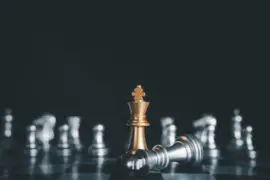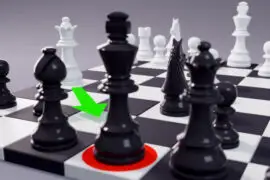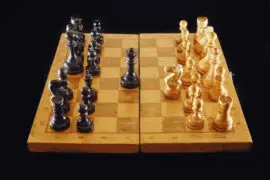Chess, a timeless game of strategy, has seamlessly transitioned into the digital realm, bringing with it a wealth of tools to unravel its complexities. At the heart of this transformation lie the Chess Analysis Icons—a visual guide that transforms the chessboard into a canvas of insights, accessible even to those with just a casual interest in the game.

The Essence of Chess Analysis Icons
Contents
Decoding the Visual Language
Chess Analysis Icons, in their essence, are like a secret language whispered across the board. Let’s break down their significance in the context of an actual game.
Symbolic Icons in Action
Consider a game where your opponent makes a bold move, advancing a pawn aggressively. A red arrow may appear, signaling a potential mistake. Simultaneously, a green square might embrace one of your pieces, indicating an opportunity to capitalize on the opponent’s move.
Numeric Insights
As you ponder your next move, numeric evaluation scores silently judge each possibility. For instance, a move might receive a +1, suggesting a slight advantage, or a -2, indicating a significant disadvantage. These scores guide your decision-making process, providing a quantitative measure of your position’s strength.
Color-Coded Emotions
Imagine a critical moment in the game where a move could alter the course of events. A yellow circle appears, cautioning you about the move’s accuracy. A green circle, on the other hand, congratulates you on a strategically sound decision. The chessboard becomes an arena of emotions, painted in reds, greens, and yellows.
The Symphony of Chess Analysis Software
Maestros of the Digital Chessboard
To truly appreciate Chess Analysis Icons, we must acquaint ourselves with the virtuosos that make them dance.
Stockfish
Let’s say you’re analyzing a game where you played a daring sacrifice, a move that left spectators in awe. Stockfish, with its numerical evaluations and symbolic arrows, dissects the move, revealing hidden depths or potential pitfalls.
lichess.org
Picture a scenario where you play a thrilling game on lichess.org. Post-game, the platform’s analysis tools spring to life, adorned with icons. Arrows guide you through the critical moments, numeric scores add context, and color-coded circles celebrate victories and highlight learning opportunities.
Deciphering the Chessboard Language
Understanding the language of icons is akin to learning the nuances of a foreign tongue.
Reading Arrows and Lines
Let’s imagine a position where your opponent’s queen is exposed. The analysis engine might suggest a move with a green arrow, guiding your rook to capture the vulnerable queen. The arrow not only points the way but also communicates the potential advantage of the move.
Numeric Evaluation Scores
As you delve into the analysis, you encounter a move that earns a +3. The numeric score is your coach’s nod of approval, urging you to recognize the brilliance of that particular move. On the flip side, a move with a -2 score signals room for improvement.
Color-Coded Icons
In a tense endgame scenario, a red square appears around your king, warning of an impending checkmate. The color-coded icons serve as a conversation between you and the software, providing instant feedback on the game’s ebb and flow.

Advanced Strategies for Iconic Victories
Diving Deeper into Analysis Techniques
Chess Analysis Icons aren’t just about pointing out moves; they’re about understanding the game’s intricate dance.
Deep Analysis: Unraveling Layers of Complexity
Imagine a game where you find yourself in a seemingly equal position. Deep analysis with multiple variations reveals a hidden tactical sequence, showcasing the power of foresight beyond a single move.
As you explore the opening phase, book icons guide you through well-known openings. For instance, a knight icon might indicate a move popularized by grandmasters, offering a glimpse into the rich history of chess openings.
Endgame Analysis: Icons Illuminate the Path to Victory
In an endgame scenario, icons highlighting king activity and pawn structure become your guiding lights. A king icon might suggest centralizing your king, while pawn structure icons provide insights into potential breakthroughs.
Tailoring Your Chess Experience
User-Friendly Interface for Personalized Play
Chess Analysis Icons are not rigid; they bend to your will, offering a personalized chess experience.
Drag-and-Drop Icons
Picture a scenario where you want to focus on a specific line of play. With a user-friendly interface, you can drag and drop icons to emphasize key moves, creating a narrative tailored to your learning objectives.
Customizing Icon Colors and Styles
In a world of vibrant icons, you might prefer a calming blue for good moves and a subdued gray for inaccuracies. Customization isn’t just about aesthetics; it’s about creating an environment that resonates with your chess journey.

Challenges and the Road Ahead
Even in the world of chess icons, challenges and criticisms loom on the horizon.
Overreliance on Icons:
Consider a scenario where a player, engrossed in the dance of icons, forgets the essence of critical thinking. Icons are guides, not substitutes for understanding the underlying principles of the game.
Misinterpretation of Analysis
Imagine a player relying solely on the color of icons without understanding the context. Misinterpretation can lead to misguided moves. Icons are aides, not replacements for strategic understanding.
Addressing the Limitations
In the midst of a challenging game, an icon might miss a subtle nuance. Acknowledging these limitations is the first step toward growth. Icons are tools, not infallible masters of the game.

The Future of Chess Analysis Icons
As we navigate the present, the future promises innovations that could redefine the landscape of chess analysis.
Integration with Artificial Intelligence
Imagine a chess analysis companion powered by artificial intelligence. It evolves with your style, learns from your mistakes, and adapts to your strategic preferences—a true digital chess mentor.
Augmented Reality Applications
Step into a world where icons seamlessly blend with reality. Augmented reality applications could turn your living room into a chess battleground, with icons guiding your moves in real-time.
Gamification of Chess Analysis
Transforming analysis into an engaging journey, where learning feels like playing. Gamification could turn every move analysis into a quest for improvement, making the learning process more enjoyable.
Learning from the Masters
From Grandmaster Games to Personal Triumphs
Let’s delve into real-world scenarios where chess analysis icons played a pivotal role.
Analysis of a Grandmaster Game
Imagine the analysis of a game between two grandmasters. Icons, like expert choreographers, guide you through the strategic ballet, unraveling the brilliance of each move.
Learning from Personal Games
In a personal game, icons become your silent mentors. As you review your moves, arrows and symbols illuminate the path to improvement, turning each game into a stepping stone toward mastery.
Highlighting Icon Usage in Tournaments
In the intensity of a tournament, icons become warriors on the chessboard. Each move is laden with meaning, and the icons narrate a story of triumphs, setbacks, and the relentless pursuit of victory.

Conclusion
Chess Analysis Icons are not just pixels on a screen; they are the brushstrokes that paint a vibrant picture of your chess journey. As you navigate the chessboard of analysis, may the icons be your guiding stars, illuminating the path to strategic triumphs and checkmates. In the ever-evolving game of chess, every move counts, and so do the icons that light your way. Happy analyzing, and may your future games be filled with the wisdom of icons and the thrill of victory!





